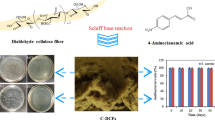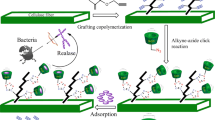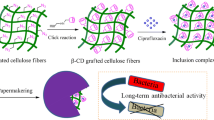Abstract
Herein, we introduce antimicrobial activity to cellulose fibers (CFs) by presenting a double “click chemistry” strategy. CFs chemically modified with azide functions are designed as a versatile ligation platform for Cu(I)-catalyzed azide-alkyne click reaction. Glycidyl propargyl ether (GPE) with epoxy groups was grafted onto azidated cellulose fibers (CFs-N3) via azide-alkyne click reaction yielding epoxy cellulose fibers (CFs-Epoxy). Then poly(hexamethylene guanidine) (PHMG) can be chemically grafted onto the CFs to form antibacterial materials (CFs-PHMG) through amino groups initiated epoxy ring-opening click reaction. The results revealed that PHMG was anchored successfully onto CFs via chemical bond formation without significant damage to the morphology of CFs and mechanical performance of cellulose paper. In the antibacterial tests, the functionalized CFs show superior antibacterial activity against E. coli and S. aureus. Importantly, CFs-PHMG paper sheet presented long-term antibacterial effectiveness, remaining ~ 99% antibacterial activity after two months storage in the air environment. This antibacterial CFs-PHMG has good potential application in bioactive paper packaging and medical paper products.
Graphic abstract









Similar content being viewed by others
References
Alonso D, Gimeno M, Olayo R, Vázquez-Torres H, Sepúlveda-Sánchez JD, Shirai K (2009) Cross-linking chitosan into UV-irradiated cellulose fibers for the preparation of antimicrobial-finished textiles. Carbohydr Polym 77(3):536–543
Bu G, Wang C, Fu S, Tian A (2012) Water-soluble cationic chitosan derivative to improve pigment-based inkjet printing and antibacterial properties for cellulose substrates. J Appl Polym Sci 125(3):1674–1680
Cai Q, Yang S, Zhang C, Li Z, Li X, Shen Z, Zhu W (2018) Facile and versatile modification of cotton fibers for persistent antibacterial activity and enhanced hygroscopicity. ACS Appl Mater Interfaces 10(44):38506–38516
Cao W, Wei D, Jiang Y, Ye S, Zheng A, Guan Y (2018) Surface chemical bonding with poly(hexamethylene guanidine) for non-leaching antimicrobial poly(ethylene terephthalate). J Mater Sci 54(3):2699–2711
Cao Y, Gu J, Wang S, Zhang Z, Yu H, Li J, Chen S (2020) Guanidine-functionalized cotton fabrics for achieving permanent antibacterial activity without compromising their physicochemical properties and cytocompatibility. Cellulose 27(10):6027–6036
Carpenter BL, Scholle F, Sadeghifar H, Francis AJ, Boltersdorf J, Weare WW, Argyropoulos DS, Maggard PA, Ghiladi RA (2015) Synthesis, characterization, and antimicrobial efficacy of photomicrobicidal cellulose paper. Biomacromol 16(8):2482–2492
Chaker A, Boufi S (2015) Cationic nanofibrillar cellulose with high antibacterial properties. Carbohydr Polym 131:224–232
Chauhan I, Mohanty P (2014) In situ decoration of TiO2 nanoparticles on the surface of cellulose fibers and study of their photocatalytic and antibacterial activities. Cellulose 22(1):507–519
Chen S, Yuan L, Li Q, Li J, Zhu X, Jiang Y, Huang P (2016) Durable antibacterial and nonfouling cotton textiles with enhanced comfort via zwitterionic sulfopropylbetaine coating. Small 12(26):3516–3521
Choi H, Kim KJ, Lee DG (2017) Antifungal activity of the cationic antimicrobial polymer-polyhexamethylene guanidine hydrochloride and its mode of action. Fungal Biol 121(1):53–60
Ding C, Sun L, **ao G, Qian X, An X (2017) Green and combinational method towards clickable alkynylated cellulose fibers (ACFs). Cellulose 24(8):3219–3229
Dong C, Ye Y, Qian L, Zhao G, He B, **ao H (2014) Antibacterial modification of cellulose fibers by grafting β-cyclodextrin and inclusion with ciprofloxacin. Cellulose 21(3):1921–1932
Du WX, Avena-Bustillos RJ, Woods R, Breksa AP, McHugh TH, Friedman M, Levin CE, Mandrell R (2012) Sensory evaluation of baked chicken wrapped with antimicrobial apple and tomato edible films formulated with cinnamaldehyde and carvacrol. J Agr Food Chem 60(32):7799–7804
Elchinger P-H, Awada H, Zerrouki C, Montplaisir D, Zerrouki R (2014) Kraft pulp-starch covalent linking: a promising route to a newmaterial. Ind Eng Chem Res 53(18):7604–7610
Fallah Z, Nasr Isfahani H, Tajbakhsh M, Tashakkorian H, Amouei A (2017) TiO2-grafted cellulose viaclickreaction: an efficient heavy metal ions bioadsorbent from aqueous solutions. Cellulose 25(1):639–660
Feese E, Sadeghifar H, Gracz HS, Argyropoulos DS, Ghiladi RA (2011) Photobactericidal porphyrin-cellulose nanocrystals: synthesis, characterization, and antimicrobial properties. Biomacromol 12(10):3528–3539
Filpponen I, Kontturi E, Nummelin S, Rosilo H, Kolehmainen E, Ikkala O (2012) Generic method for modular surface modification of cellulosic materials in aqueous medium by sequential “click” reaction and adsorption. Biomacromol 13(3):736–742
Fox SC, Li B, Xu D, Edgar KJ (2011) Regioselective esterification and etherification of cellulose: a review. Biomacromol 12(6):1956–1972
Gu J, Yuan L, Zhang Z, Yang X, Luo J, Gui Z, Chen S (2018) Non-leaching bactericidal cotton fabrics with well-preserved physical properties, no skin irritation and no toxicity. Cellulose 25(9):5415–5426
Guan Y, **ao H, Sullivan H, Zheng A (2007) Antimicrobial-modified sulfite pulps prepared by in situ copolymerization. CarbohydrPolym 69(4):688–696
Guan Y, Qian L, **ao H, Zheng A (2008) Preparation of novel antimicrobial-modified starch and its adsorption on cellulose fibers: part I. Optimization of synthetic conditions and antimicrobial activities. Cellulose 15(4):609–618
Hou A, Zhou M, Wang X (2009) Preparation and characterization of durable antibacterial cellulose biomaterials modified with triazine derivatives. Carbohydr Polym 75(2):328–332
Huang X, Shen J, Qian X (2013) Filler modification for papermaking with starch/oleic acid complexes with the aid of calcium ions. Carbohydr Polym 98(1):931–935
Illergård J, Römling U, Wågberg L, Ek M (2012) Biointeractive antibacterial fibres using polyelectrolyte multilayer modification. Cellulose 19(5):1731–1741
Islam MS, Akter N, Rahman MM, Shi C, Islam MT, Zeng H, Azam MS (2018) Mussel-inspired immobilization of silver nanoparticles toward antimicrobial cellulose paper. ACS Sustain Chem Eng 6(7):9178–9188
Kolb HC, Finn MG, Sharpless KB (2001) Click chemistry: diverse chemical function from a few good reactions. Angew Chem Int Edit 40(11):2004–2021
Lavoine N, Desloges I, Sillard C, Bras J (2014) Controlled release and long-term antibacterial activity of chlorhexidine digluconate through the nanoporous network of microfibrillated cellulose. Cellulose 21(6):4429–4442
Li H, Peng L (2015) Antimicrobial and antioxidant surface modification of cellulose fibers using layer-by-layer deposition of chitosan and lignosulfonates. Carbohydr Polym 124:35–42
Li Z, Chen J, Cao W, Wei D, Zheng A, Guan Y (2018) Permanent antimicrobial cotton fabrics obtained by surface treatment with modified guanidine. Carbohydr Polym 180:192–199
Lin L, Dai Y, Cui H (2017) Antibacterial poly(ethylene oxide) electrospun nanofibers containing cinnamon essential oil/beta-cyclodextrin proteoliposomes. Carbohydr Polym 178:131–140
Liu Z, Xu M, Wang Q, Li B (2017) A novel durable flame retardant cotton fabric produced by surface grafting of phosphorus- and nitrogen-containing compounds. Cellulose 24(9):4069–4081
Mahadeva SK, Walus K, Stoeber B (2014) Piezoelectric paper fabricated via nanostructured barium titanate functionalization of wood cellulose fibers. ACS Appl Mater Interfaces 6(10):7547–7553
Mangiante G, Alcouffe P, Burdin B, Gaborieau M, Zeno E, Petit-Conil M, Bernard J, Charlot A, Fleury E (2013) Green nondegrading approach to alkyne-functionalized cellulose fibers and biohybrids thereof: synthesis and map** of the derivatization. Biomacromol 14:254–263
Mao H, Dong Y, Qian X, An X (2017) Enhancement of bonding strength of polypyrrole/cellulose fiber (PPy/CF) hybrid through lignosulfonate do**. Cellulose 24(5):2255–2263
Maver T, Maver U, Mostegel F, Griesser T, Spirk S, Smrke DM, Stana-Kleinschek K (2014) Cellulose based thin films as a platform for drug release studies to mimick wound dressing materials. Cellulose 22(1):749–761
Meng X, Edgar KJ (2016) “Click” reactions in polysaccharide modification. Prog Polym Sci 53:52–85
Neal AL (2008) What can be inferred from bacterium-nanoparticle interactions about the potential consequences of environmental exposure to nanoparticles? Ecotoxicology 17(5):362–371
Nongbe MC, Bretel G, Ekou L, Ekou T, Robitzer M, Le Grognec E, Felpin F-X (2018) Cellulose paper azide as a molecular platform forversatile click ligations: application to the preparation of hydrophobic paper surface. Cellulose 25(2):1395–1411
Park JH, Oh KW, Choi HM (2013) Preparation and characterization of cotton fabrics with antibacterial properties treated by crosslinkable benzophenone derivative in choline chloride-based deep eutectic solvents. Cellulose 20(4):2101–2114
Parsamanesh M, Dadkhah Tehrani A (2016) Synthesize of new fluorescent polymeric nanoparticle using modified cellulose nanowhisker through click reaction. Carbohydr Polym 136:1323–1331
Peila R, Vineis C, Varesano A, Ferri A (2013) Different methods for β-cyclodextrin/triclosan complexation as antibacterial treatment of cellulose substrates. Cellulose 20(4):2115–2123
Rahman NSA, Ahmad NA, Yhaya MF, Azahari B, Ismail WR (2016) Crosslinking of fibers via azide–alkyne click chemistry: synthesis and characterization. J Appl Polym Sci 133(25):1–8
Rong L, Liu H, Wang B, Mao Z, Xu H, Zhang L, Zhong Y, Feng X, Sui X (2019) Durable antibacterial and hydrophobic cotton fabrics utilizing enamine bonds. Carbohydr Polym 211:173–180
Roy D, Knapp JS, Guthrie JT, Perrier S (2008) Antibacterial cellulose fiber via raft surface graft polymerization. Biomacromol 9(1):91–99
Sadeghifar H, Venditti R, Jur J, Gorga RE, Pawlak JJ (2016) Cellulose-lignin biodegradable and flexible UV protection film. ACS Sustain Chem Eng 5(1):625–631
Saif MJ, Zia KM, Rehman FU, Ahmad MN, Kiran S, Gulzar T (2014) An eco-friendly, permanent, and non-leaching antimicrobial coating on cotton fabrics. J Text I 106(9):907–911
Seabra AB, Bernardes JS, Favaro WJ, Paula AJ, Duran N (2018) Cellulose nanocrystals as carriers in medicine and their toxicities: a review. Carbohydr Polym 181:514–527
Sehmi SK, Noimark S, Weiner J, Allan E, MacRobert AJ, Parkin IP (2015) Potent antibacterial activity of copper embedded into silicone and polyurethane. ACS Appl Mater Interfaces 7(41):22807–22813
Su X, Liao Q, Liu L, Meng R, Qian Z, Gao H, Yao J (2016) Cu2O nanoparticle-functionalized cellulose-based aerogel as high-performance visible-light photocatalyst. Cellulose 24(2):1017–1029
Sun L, Qian X, Ding C, An X (2018) Integration of graft copolymerization and ring-opening reaction: a mild and effective preparation strategy for “clickable” cellulose fibers. Carbohydr Polym 198:41–50
Sun L, Ding C, Qian X, An X (2019) Effective and simple one-step strategy for preparation of “clickable” cellulose modules: support to build antibacterial materials. Cellulose 26(3):1961–1976
Tang J, Song Y, Tanvir S, Anderson WA, Berry RM, Tam KC (2015) Polyrhodanine coated cellulose nanocrystals: a sustainable antimicrobial agent. ACS Sustain Chem Eng 3(8):1801–1809
Tunç S, Duman O (2011) Preparation of active antimicrobial methyl cellulose/carvacrol/montmorillonite nanocomposite films and investigation of carvacrol release. LWT Food Sci Technol 44(2):465–472
Tyagi P, Mathew R, Opperman CH, Jameel H, Gonzalez RW, Lucia LA, Hubbe MA, Pal L (2018) High strength antibacterial chitosan-cellulose nanocrystals composite tissue paper. Langmuir 35:104–112
Wang C, Qian X, An X (2015) In situ green preparation and antibacterial activity of copper-based metal–organic frameworks/cellulose fibers (HKUST-1/CF) composite. Cellulose 22(6):3789–3797
Wang Q, Chen G, Yu Z, Ouyang X, Tian J, Yu M (2018) Photoluminescent composites of lanthanide-based nanocrystal-functionalized cellulose fibers for anticounterfeiting applications. ACS Sustain Chem Eng 6(11):13960–13967
Wei D, Zhou R, Guan Y, Zheng A, Zhang Y (2013) Investigation on the reaction between polyhexamethylene guanidine hydrochloride oligomer and glycidyl methacrylate. J Appl Polym Sci 127(1):666–674
Wei D, Li Z, Wang H, Liu J, **ao H, Zheng A, Guan Y (2017) Antimicrobial paper obtained by dip-coating with modified guanidine-based particle aqueous dispersion. Cellulose 24(9):3901–3910
**ao M, Hu J (2017) Cellulose/chitosan composites prepared in ethylene diamine/potassium thiocyanate for adsorption of heavy metal ions. Cellulose 24(6):2545–2557
**ao G, Ding C, Song F, Qian X, An X (2016) Facile strategy for preparation of alkyne-functionalized cellulose fibers with click reactivity. Cellulose 24(2):591–607
Xu WZ, Gao G, Kadla JF (2013) Synthesis of antibacterial cellulose materials using a “clickable” quaternary ammonium compound. Cellulose 20(3):1187–1199
Xu C, Hu X, Wang J, Zhang YM, Liu XJ, **e BB, Yao C, Li Y, Li XS (2015) Library of antifouling surfaces derived from natural amino acids by click reaction. ACS Appl Mater Interfaces 7(31):17337–17345
Yang H, van de Ven TG (2016) A bottom-up route to a chemically end-to-end assembly of nanocellulose fibers. Biomacromol 17(6):2240–2247
Yoosefi Booshehri A, Wang R, Xu R (2015) Simple method of deposition of CuO nanoparticles on a cellulose paper and its antibacterial activity. Chem Eng J 262:999–1008
Youssef AM, Kamel S, El-Samahy MA (2013) Morphological and antibacterial properties of modified paper by PS nanocomposites for packaging applications. Carbohydr Polym 98(1):1166–1172
Yu X, Tong S, Ge M, Wu L, Zuo J, Cao C, Song W (2013) Synthesis and characterization of multi-amino-functionalized cellulose for arsenic adsorption. Carbohydr Polym 92(1):380–387
Yu D, Xu L, Hu Y, Li Y, Wang W (2017) Durable antibacterial finishing of cotton fabric based on thiol–epoxy click chemistry. RSC Adv 7(31):18838–18843
Zahid M, Papadopoulou EL, Suarato G, Binas VD, Kiriakidis G, Gounaki I, Moira O, Venieri D, Bayer IS, Athanassiou A (2018) Fabrication of visible light-induced antibacterial and self-cleaning cotton fabrics using manganese doped TiO2 nanoparticles. ACS Appl Bio Mater 1(4):1154–1164
Zhao SW, Zheng M, Zou XH, Guo Y, Pan QJ (2017) Self-assembly of hierarchically structured cellulose@ZnO composite in solid–liquid homogeneous phase: synthesis, DFT calculations, and enhanced antibacterial activities. ACS Sustain Chem Eng 5(8):6585–6596
Acknowledgments
The authors gratefully acknowledge the National Natural Science Foundation of China (Grant no. 31370579) for financial support to this work.
Author information
Authors and Affiliations
Corresponding author
Additional information
Publisher's Note
Springer Nature remains neutral with regard to jurisdictional claims in published maps and institutional affiliations.
Rights and permissions
About this article
Cite this article
Sun, L., Yang, S., Qian, X. et al. High-efficacy and long term antibacterial cellulose material: anchored guanidine polymer via double “click chemistry”. Cellulose 27, 8799–8812 (2020). https://doi.org/10.1007/s10570-020-03374-5
Received:
Accepted:
Published:
Issue Date:
DOI: https://doi.org/10.1007/s10570-020-03374-5




